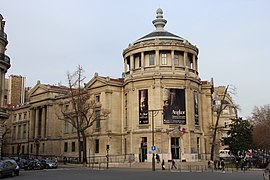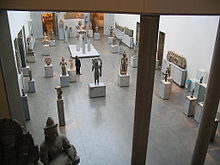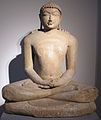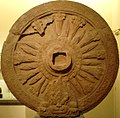art.wikisort.org - Museum
The Guimet Museum (full name in French: Musée national des arts asiatiques-Guimet; MNAAG), abbr. Musée Guimet, is an art museum located at 6, place d'Iéna in the 16th arrondissement of Paris, France. Literally translated into English, its full name is the National Museum of Asian Arts-Guimet, or Guimet National Museum of Asian Arts.
 The museum in December 2013 | |
 Location within Paris | |
| Established | 1879 |
|---|---|
| Coordinates | 48°51′55″N 2°17′38″E |
| Type | Asian art |
| Website | www |
The museum has one of the largest collections of Asian art outside of Asia.
History


Founded by Émile Étienne Guimet, an industrialist, the museum first opened at Lyon in 1879[1] but was later transferred to Paris, opening in the place d'Iéna in 1889.[2] Devoted to travel, Guimet was in 1876 commissioned by the minister of public instruction to study the religions of the Far East, and the museum contains many of the fruits of this expedition, including a fine collection of Chinese and Japanese porcelain and objects relating not merely to the religions of the East, but also to those of ancient Egypt, Greece and Rome. One of its wings, the Panthéon Bouddhique, displays Buddhist artworks.
Some of the museum's artifacts, originating from Khmer culture in Cambodia, Buddhist art from Vietnam and Indonesia, were stolen from Southeast Asia by French authorities and research institutions during the colonial period.[3]
From December 2006 to April 2007, the museum harboured collections of the Kabul Museum, with archaeological pieces from the Greco-Bactrian city of Ai-Khanoum, and the Indo-Scythian treasure of Tillia Tepe.
Works of art of the museum
Greco-Buddhist art
- Gandhara Buddha, 1st–2nd century CE
- Hellenistic decorative scrolls from Hadda, northern Afghanistan
- Standing Buddha, ancient region of Gandhara, northern Afghanistan, 1st century
- Stone palette of a Nereid sea-goddess riding a Ketos sea-monster, Sirkap, 2nd century BCE
- Wine-drinking and music, Hadda, 1st–2nd century CE
- A Corinthian capitol with a Buddha at its center, 2nd century, Surk Kotal, Afghanistan
- The Greek god Atlas, supporting a Buddhist monument, Hadda
- The Bodhisattva Maitreya, 2nd century, Gandhara
- Scene of the life of the Buddha. 2nd–3rd century. Gandhara
- Portraits from the site of Hadda, 3rd century
- Statuette excavated from the Dharmarajika Stupa site at Sirkap, Pakistan
Serindian art
- "Heroic gesture of the Bodhisattva", 6th–7th century terracotta, Tumshuq (Xinjiang)
- Head of a Bodhisattva, 6th–7th century terracotta, Tumshuq (Xinjiang)
Chinese art
- Han Dynasty Horse (1st–2nd century)
- Buddha triad, Eastern Wei (534–550), China
- Tang dynasty Foreign Merchant
- Northern Qi depiction of Sogdians
- One of the Group of glazed pottery luohans from Yixian, c. 1000
- A sitting celadon lion, dated 11th to 12th century, Song dynasty
- A porcelain vase with design of men fighting on horseback, from the Jiajing reign period (1521–1567), Ming dynasty
- A round sancai dish from the Tang dynasty, 8th to 9th century
 Painting Bodhisattva Who Leads the Way from Mo-kao caves, 900–950 A.D.
Painting Bodhisattva Who Leads the Way from Mo-kao caves, 900–950 A.D.
Indian art
- An aniconic representation of Mara's assault on the Buddha, 2nd century, Amaravati style, eastern India
- The Bodhisattva Maitreya, 2nd century, Mathura
- A Buddha, 2nd century, Mathura
- Buddha of the Gupta period, 5th century, Mathura
- Head of a Buddha, Gupta period, 6th century
- Rishabhanatha, sandstone, Madhya Pradesh, Chandela period, 10th–11th century
- Buddha and Bodhisattvas, 11th century, Pala Empire
- Vishnu, Madhya Pradesh, 11th–12th century
- Shiva from Tamil Nadu, Chola period, 11th century
- Rishabhanatha, 11th–12th century, Orissa
Southeast Asian art
- Head of Buddha taken from Borobudur, c. 8th–9th century Central Java, Indonesia
- Agastya, c. 8th–9th century Central Java, Indonesia
- Hindu deity Brahma, Cambodia
- Brahma 10th century, Khmer art, Cambodia
- Shiva from Vijayapura, Vietnam
- Vishnu on Garuda, Champa art, Vietnam
- Ganesha, Siem Reap, Cambodia, c. 12th–13th century
- Mons Wheel of the Law (Dharmacakra), art of Dvaravati, c. 8th century
- A Cambodian Buddha, 14th century
- Bodhisattva Lokiteśvara, Cambodia 12th century
See also
- List of museums in Paris
Notes
- History of the Museum (in French).
- National museum Arts asiatiques – Guimet, Marie-Catherine Rey et al. Paris: Éditions de la Réunion des Musées nationaux, 2001, translation by John Adamson, ISBN 2711838978, Chronology, p. 6.
- Howlett-Martin, Patrick (2012-07-01). "Où ira le buste de Néfertiti ?". Le Monde diplomatique (in French). Retrieved 2021-10-17.
External links
- Musée Guimet
- Musée national des arts Asiatiques Guimet, special issue of art magazine Connaissance des Arts, available in French and English
На других языках
[de] Musée Guimet
Das Musée Guimet (offiziell Musée national des Arts asiatiques – Guimet, MNAAG; „Nationales Museum der asiatischen Künste“) ist ein auf Initiative des Industriellen Émile Guimet im Jahr 1889 im 16. Arrondissement von Paris errichtetes, heute staatliches Museum asiatischer Künste. Die langjährige Kuratorin Jeannine Auboyer gestaltete es 1960 um und erweiterte es 1991 um die Panthéon bouddhique („buddhistisches Pantheon“) genannte Dépendance im früheren Hôtel Heidelbach. Zu dem Museum gehört ein kleiner japanischer Garten. Als dritter Standort gehört seit 2012 auch das Musée d’Ennery dazu.- [en] Guimet Museum
[es] Museo Guimet
El Museo Guimet (en francés, Musée national des Arts asiatiques-Guimet o Musée Guimet) es un museo de Francia de arte asiático localizado en la avenue d'Iéna, en el XVI distrito de París. Posee una de las más grandes colecciones del arte de Asia del mundo occidental.[fr] Musée national des Arts asiatiques - Guimet
Le Musée national des Arts asiatiques - Guimet, abrégé en MNAAG et appelé encore couramment musée Guimet, est un musée d'arts asiatiques situé à Paris, 6, place d'Iéna, dans le 16e arrondissement. Conçu, lors de sa rénovation, en 1997, comme un grand centre de la connaissance des civilisations asiatiques au cœur de l’Europe, il présente aujourd'hui, regroupée dans un espace qui leur est dédié, l'une des plus complètes collections d'arts asiatiques au monde.Другой контент может иметь иную лицензию. Перед использованием материалов сайта WikiSort.org внимательно изучите правила лицензирования конкретных элементов наполнения сайта.
WikiSort.org - проект по пересортировке и дополнению контента Википедии







































